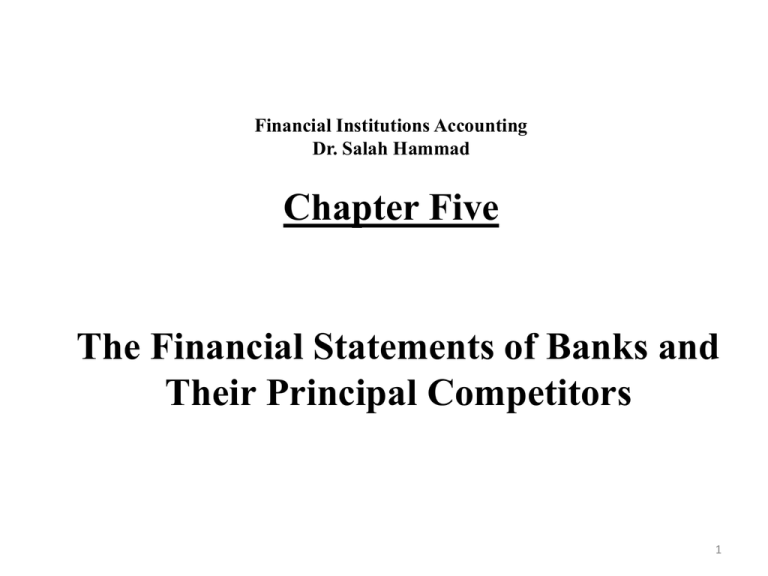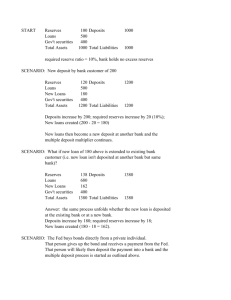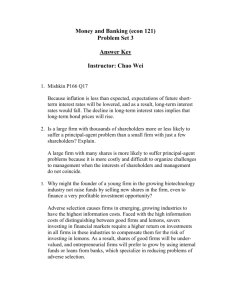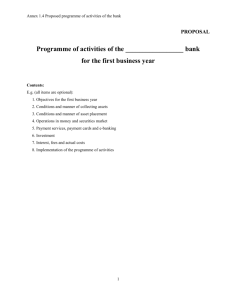chapter 5 (1)
advertisement

Financial Institutions Accounting Dr. Salah Hammad Chapter Five The Financial Statements of Banks and Their Principal Competitors 1 Introduction • The particular services each financial firm chooses to offer and the overall size of each financial-service organization are reflected in its financial statements • Financial statements can be viewed as a “road map” ▫ Tell us where a financial firm has been in the past, where it is now, and possibly where it is headed in the future • The two main financial statements that managers, customers, and the regulatory authorities rely upon are ▫ The balance sheet (Report of Condition) ▫ The income statement (Report of Income) 2 An Overview of Balance Sheets and Income Statements • The Report of Condition shows the amount and composition of funds sources (financial inputs) drawn upon to finance lending and investing activities and how much has been allocated to loans, securities, and other funds uses (financial outputs) at any given point in time • In contrast, the financial inputs and outputs on the Report of Income show how much it has cost to acquire funds and to generate revenues from the uses the financial firm has made of those funds • The Report of Income also shows the revenues (cash flow) generated by selling services to the public, including making loans and servicing customer deposits • The Report of Income shows net earnings after all costs are deducted from the sum of all revenues, some of which will be reinvested in the financial firm for future growth and some of which will flow to stockholders as dividends 3 TABLE 5–1 Key Items on Bank Financial Statements 4 The Balance Sheet (Report of Condition) • A balance sheet lists the assets, liabilities, and equity capital (owners’ funds) held by or invested in a bank or other financial firm on any given date 5 The Balance Sheet (Report of Condition) (continued) • For banks and other depository institutions the assets on the balance sheet are of four major types: ▫ Cash in the vault and deposits held at other depository institutions (C) ▫ Government and private interest-bearing securities purchased in the open market (S) ▫ Loans and lease financings made available to customers (L) ▫ Miscellaneous assets (MA) • Liabilities fall into two principal categories: ▫ Deposits made by and owed to various customers (D) ▫ Nondeposit borrowings of funds in the money and capital markets (NDB) • Equity capital represents long-term funds the owners contribute (EC) 6 The Balance Sheet (Report of Condition) (continued) • Cash assets (C) are designed to meet the financial firm’s need for liquidity • Security holdings (S) are a backup source of liquidity and include investments that provide a source of income • Loans (L) are made principally to supply income • Miscellaneous assets (MA) are usually dominated by fixed assets (plant and equipment) and investments in subsidiaries (if any) • Deposits (D) are typically the main source of funding for banks ▫ Nondeposit borrowings (NDB) are carried out mainly to supplement deposits and provide the additional liquidity that cash assets and securities cannot provide • Equity capital (EC) supplies the long-term, relatively stable base of financial support upon which the financial firm will rely to grow and to cover any extraordinary losses it incurs 7 The Balance Sheet (Report of Condition) (continued) • One useful way to view the balance sheet identity is to note that liabilities and equity capital represent accumulated sources of funds, which provide the needed spending power to acquire assets • A bank’s assets, on the other hand, are its accumulated uses of funds, which are made to generate income for its stockholders, pay interest to its depositors, and compensate its employees for their labor and skill • Thus, the balance sheet identity can be pictured simply as: 8 TABLE 5–3 Report of Condition (Balance Sheet) for BB&T (Year-End 2008 and 2009) 9 The Balance Sheet (Report of Condition) (continued) • Cash Assets ▫ Account is called Cash and Deposits Due from Bank ▫ Includes: ▫ ▫ ▫ ▫ Vault Cash Deposits with Other Banks (Correspondent Deposits) Cash Items in Process of Collection Reserve Account with the Federal Reserve ▫ Sometimes called primary reserves 10 The Balance Sheet (Report of Condition) (continued) • Investment Securities - The Liquid Portion ▫ Short Term Government Securities ▫ Privately Issued Money Market Securities ▫ Interest Bearing Time Deposits ▫ Commercial Paper ▫ Often called secondary reserves 11 The Balance Sheet (Report of Condition) (continued) • Investment Securities - The Income-Generating Portion ▫ Taxable Securities ▫ U.S. Government Notes ▫ Government Agency Securities ▫ Corporate Bonds ▫ Tax-Exempt Securities ▫ Municipal Bonds 12 The Balance Sheet (Report of Condition) (continued) • Trading Account Assets ▫ Securities purchased to provide short-term profits from short-term price movements ▫ Occurs when the bank acts as a securities dealer ▫ Valued at Market – FASB 115 13 The Balance Sheet (Report of Condition) (continued) • Federal Funds Sold and Reverse Repurchase Agreements ▫ Includes mainly temporary loans (usually extended overnight, with the funds returned the next day) made to other depository institutions, securities dealers, or major industrial corporations ▫ The funds for these temporary loans often come from the reserves a bank has on deposit with the Federal Reserve Bank in its district ▫ “Fed funds” ▫ Some of these temporary credits are extended in the form of reverse repurchase (resale) agreements (RPs) in which the banking firm acquires temporary title to securities owned by the borrower and holds those securities as collateral until the loan is paid off 14 The Balance Sheet (Report of Condition) (continued) • Loan Accounts ▫ The Major Asset ▫ Gross Loans – Sum of All Loans ▫ Allowance for Possible Loan Losses ▫ Contra Asset Account ▫ For Potential Future Loan Losses ▫ Net Loans ▫ Unearned Discount Income ▫ Nonperforming Loans 15 The Balance Sheet (Report of Condition) (continued) • Types of Loans ▫ ▫ ▫ ▫ ▫ ▫ ▫ ▫ Commercial and industrial (or business) loans Consumer (or household) loans Real estate (or property-based) loans Financial institutions loans Foreign (or international) loans Agricultural production loans Security loans Leases 16 The Balance Sheet (Report of Condition) (continued) • Loan Losses Beginning Allowance for Loan Losses + This Year’s Provision for Loan Loss = Adjusted Allowance for Loan Losses - Actual Charge-Offs of Worthless Loans + Recoveries from Previous Charge-Offs = Ending Allowance for Loan Losses 17 The Balance Sheet (Report of Condition) (continued) • Specific and General Reserves ▫ Specific Reserves ▫ Set aside to cover a particular Loan ▫ Designate a portion of ALL or ▫ Add more reserves to ALL ▫ General Reserves ▫ Remaining ALL ▫ Determined by management but influenced by taxes and government regulation ▫ Loans to lesser developed countries require allocated transfer reserves 18 The Balance Sheet (Report of Condition) (continued) • Miscellaneous Assets ▫ Bank Premises and Fixed Assets ▫ Other Real Estate Owned (OREO) ▫ Goodwill and Other Intangibles 19 The Balance Sheet (Report of Condition) (continued) • Liabilities of the Banking Firm ▫ Deposits ▫ ▫ ▫ ▫ ▫ Non interest-Bearing Demand Deposits Savings Deposits Now Accounts Money Market Deposit Accounts (MMDA) Time Deposits 20 The Balance Sheet (Report of Condition) (continued) • Liabilities of the Banking Firm ▫ Nondeposit Borrowings ▫ Fed Funds Purchased ▫ Securities Sold Under Agreement to Repurchase (Repurchase Agreements) ▫ Acceptances Outstanding ▫ Eurocurrency Borrowings ▫ Subordinated Debt ▫ Limited Life Preferred Stock ▫ Other Liabilities 21 The Balance Sheet (Report of Condition) (continued) • Equity Capital of the Banking Firm ▫ ▫ ▫ ▫ ▫ ▫ ▫ Preferred Stock Common Stock Common Stock Outstanding Capital Surplus Retained Earnings (Undivided Profits) Treasury Stock Contingency Reserve 22 The Balance Sheet (Report of Condition) (continued) • Recent Expansion of Off-Balance-Sheet (OBS) Items in Banking ▫ Unused Commitments ▫ Standby Credit Agreements ▫ Derivative Contracts ▫ Futures Contracts ▫ Options ▫ Swaps ▫ OBS transactions expose a firm to counterparty risks ▫ OBS items have grown so rapidly that, for the banking industry as a whole, they exceed total bank assets many times over 23 TABLE 5–5 Examples of Off-Balance-Sheet Items Reported by FDIC-Insured Banks 24 Components of the Income Statement (Report of Income) • Indicates the amount of revenue received and expenses incurred over a specific period of time • Shows how much it has cost to acquire funds and to generate revenues from the uses of funds in the Report of Conditions • Shows the revenues (cash flow) generated by selling services to the public • Shows net earnings after all costs are deducted from the sum of all revenues 25 Components of the Income Statement (Report of Income) (continued) 26 Components of the Income Statement (Report of Income) (continued) • Income statements are a record of financial flows over time • Therefore, we can represent the income statement as a report of financial outflows (expenses) and financial inflows (revenues) • Four main sections 1. 2. 3. 4. Interest income Interest expenses Noninterest income Noninterest expenses 27 TABLE 5–6 Report of Income (Income Statement) for BB&T (2008 and 2009) 28 Components of the Income Statement (Report of Income) (continued) • Net Interest Income = Interest Income – Interest Expenses • Interest Income Sources ▫ ▫ ▫ ▫ Interest and Fees on Loans Taxable Securities Revenue Tax-Exempt Securities Revenue Other Interest Income • Interest Expense Sources ▫ Deposit Interest Costs ▫ Interest on Short-Term Debt ▫ Interest on Long-Term Debt 29 Components of the Income Statement (Report of Income) (continued) • Net Noninterest Income = Noninterest Income – Noninterest Expenses • Noninterest Income Sources ▫ ▫ ▫ ▫ Fees Earned from Fiduciary Activities Service Charges on Deposit Accounts Trading Account Gains and Fees Additional Noninterest Income • Noninterest Expense Sources ▫ Wages, Salaries, and Employee Benefits ▫ Premises and Equipment Expense ▫ Other Operating Expenses 30







